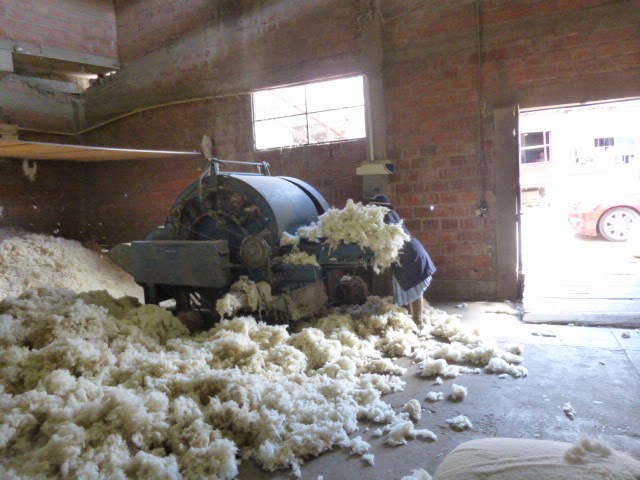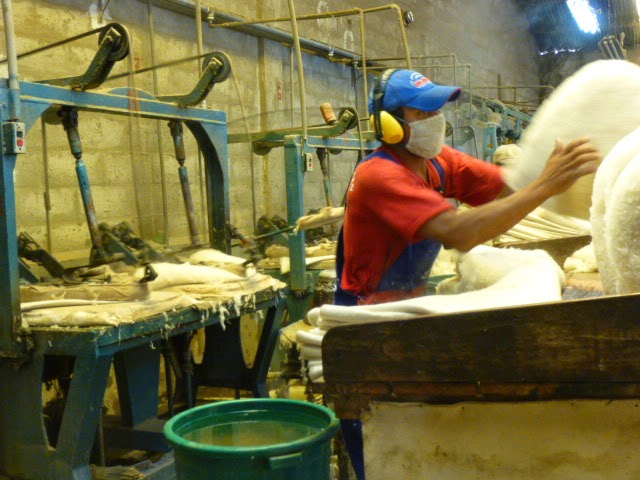Last week we spent 3 days in Sucre, the capital city of Bolivia. It is not the largest city in the county by far (only 300,000 residents) and everyone talks about La Paz as the "real" capital, so I did a little research as to what's what (courtesy of BoliviaBella.com). If you're not interested in history, just skip the next few paragraphs. I find it fascinating.
When the Spanish colonized the Americas, they divided the continent into viceroyalties – large territories, each governed by a viceroy. Bolivia was initially a part of what was known as the Viceroyalty of Alto Peru which included what are now Peru, Bolivia, and parts of Chile. In 1825, when Bolivia gained its independence, it was founded as a Republic in the city of Sucre which was established as Bolivia’s capital city. During this time, silver and tin mining were the country’s largest industries. Tin and silver were being mined in Potosí, west of Sucre and a great number of silver mine owners lived in Sucre (hence the huge colonial-style homes.)
Bolivia experienced a lot of upheaval during its first decades as a sovereign nation. (Just as a clue: there have been 65 presidents since 1825!) In 1899 Bolivia’s Liberal Party and Conservative Party clashed in a struggle for political power. Sucre’s silver owners and large landowners supported the conservatives. Tin mine owners (many of whom lived in La Paz) threw their support behind the Liberal Party. The Liberals overthrew the Conservatives and immediately bid to move the country’s seat of government to La Paz.
In the end, an agreement was reached. La Paz became the seat of the executive and legislative branches of the Bolivian government and the judicial branch remained in Sucre. Today Sucre remains as the one and only capital of Bolivia, per the Bolivian constitution. However, La Paz is sometimes erroneously called the administrative (or de facto) capital.
In September of 2008 thousands of Sucrenses participated in protests and manifestations, wanting to move all branches of the government back to Sucre. The government accused them of promoting division and separatism in the country. Sucrenses were called enemies of the state.
President Evo Morales (the current anti-American president - an Aymara Indian - who will undoubtedly be re-elected this fall) and his political party the M.A.S. (Movimiento al Socialismo - Movement Toward Socialism) swiftly drafted a new Bolivian constitution amid much protest and violence throughout most of 2008. Interestingly, the New Bolivian Constitution proposed by President Morales was approved by a narrow margin of just over 50%. Sucre remains the capital of Bolivia and La Paz the seat of government. The new constitution was approved by only 4 of Bolivia's 9 states (all 4 in Western Bolivia) and was not approved by 5 states (in the Eastern half of the country). Even though more states voted against it, the new constitution passed because the states that voted to approve it are more populated and have more voters.
And just as an interesting side note: Sucre is supposed to get a new international airport, but because Morales knows the Sucrenses are opposed to him, he tries as much as he can to withhold the funds they need to build said airport. Consequently it has been under construction for at least 2 years and will be for several years more.
Anyway, Sucre is our favorite city in Bolivia. It is far cleaner than any other city; the historic downtown buildings are all painted white so it glistens in the sunshine; and the feeling in the city is just "nicer" than anywhere else we've been.
The most significant part of our visit this time was a tour of Sombreros de Sucre - a hat factory, so the rest of today's post will be about that. Here we go . . .
This is our group at the airport on Tuesday, August 19th. L/R, Harriet and Helen (sorry I don't know their last names! They are Lynda Westover's 91-year-old aunt and 87-year-old friend who are here visiting from the U.S. for 2 weeks). Then the Westovers, the Runquists, and us.
The outside of the hat factory.
As we walked in, we passed bundles of wool like this . . .
. . . and like this.
This is a display in the registration room.
Now we're down in the factory.
This is the first washing vat (the wool is on the bottom, under the water.)
The vat is filled with a mixture of HOT water and some sulphuric acid, to remove the natural grease.
It smells nasty, by the way.
This is the second washing vat - more of the same.
Here is the first-stage of the drying process.

And the second stage. Notice everything is stirred and moved by hand.
Here's what it looks like after being washing and rinsed.
Next it goes into this big machine I call a "shredder".
There are sharp metal teeth - or combs - that pull it apart.
From there it goes to this machine (the next 3 pictures) where Bolivian wool and Argentine wool are fed into the machine together and blown out the other end as a mixture of the two. This apparently makes for a stronger, more durable fabric. (Notice the open gears and total absence of any kind of safety gear other than the mask she is wearing.)
The combined wool then goes on this machine that turns it from clumps into a sheet of fabric.
(Next 2 pictures)
It comes off the above machine in a wide swath, and then is transferred to this narrower machine.
I don't know if they double it over, or what.
It comes off this machine in a steady "stream" of cloth.
The worker shapes it around what they call a "bell".
I took several pictures hoping you could see what she is doing.
It's a continuous motion, so to speak.
When it's just the right thickness, she cuts it in half.
This creates the size and shape they need to work with.
These are stacks of the wool/fabric cut off the "bell".
Next the pieces are pressed under steaming hot irons (behind him).
Notice one man is wearing a protective mask but the other is not.
I guess it's an individual choice.
We could see no evidence of any kind of safety requirements for anyone.
These two workers trim off the uneven edges so all the pieces are uniform.
Here's what the pieces look like after they are pressed and trimmed.
I honestly have no idea what is the purpose of this step.
The cut and trimmed pieces are wrapped inside a big wet piece of leather and run through this press.
They come out wetter and flatter, that's all I can figure out.
Somehow I totally missed photographing the coloring process.
Here's one shot our friend Don Runquist took.
The machine on the left is dying white; in the center, brown.
Behind these two machines there are more - lots of different colors.
Here are two pictures of the shaping process. This man works hard and fast.
Then the hats are "buffed" on grinding wheels.
This struck me as a "sweatshop" kind of environment.
The workers are packed in so tight they are elbow to elbow.
However, the windows are open and there is at least light.
You'll notice most of them wear protective masks so they don't breathe in quite so much lint.
The next step is to iron and shape the brim of the hat.
That's what this man is doing. (There were 2 of them working at this task.)
And here's a table of hats waiting to be taken to the trimming floor.
This is looking down the length of the trimming floor.
It's up one level; cleaner and better air, not much light though.
And finally, you end up in the sales room with a lot of beautiful hats just waiting to be tried on.
They have everything from Boy Scout/Mountie hats to very-stylish dressy hats for ladies,
and they come in every color of the rainbow.
The average price on these hats is $10 (American) - a real steal.
Elder Runquist in the gaucho hat he bought.
Sister Runquist with her cholita hat.
It's not too small for her; they really DO sit on top of the head like that.
Sister Westover with her cholita hat.
And Farron with his cowboy hat, in which I think he looks TERRIFIC!
I took this back at the hotel because the one I took at the factory didn't turn out well.
Okay, that's it for today. Next week some other interesting stuff from our visit to Sucre. Have a safe, happy, healthy week . . . y vayan con Dios!


























































